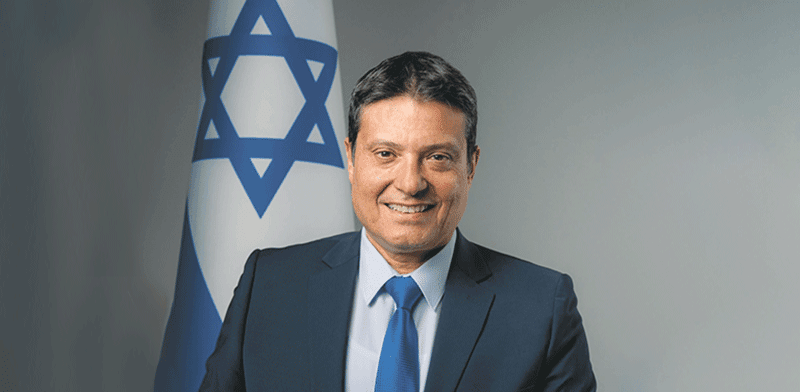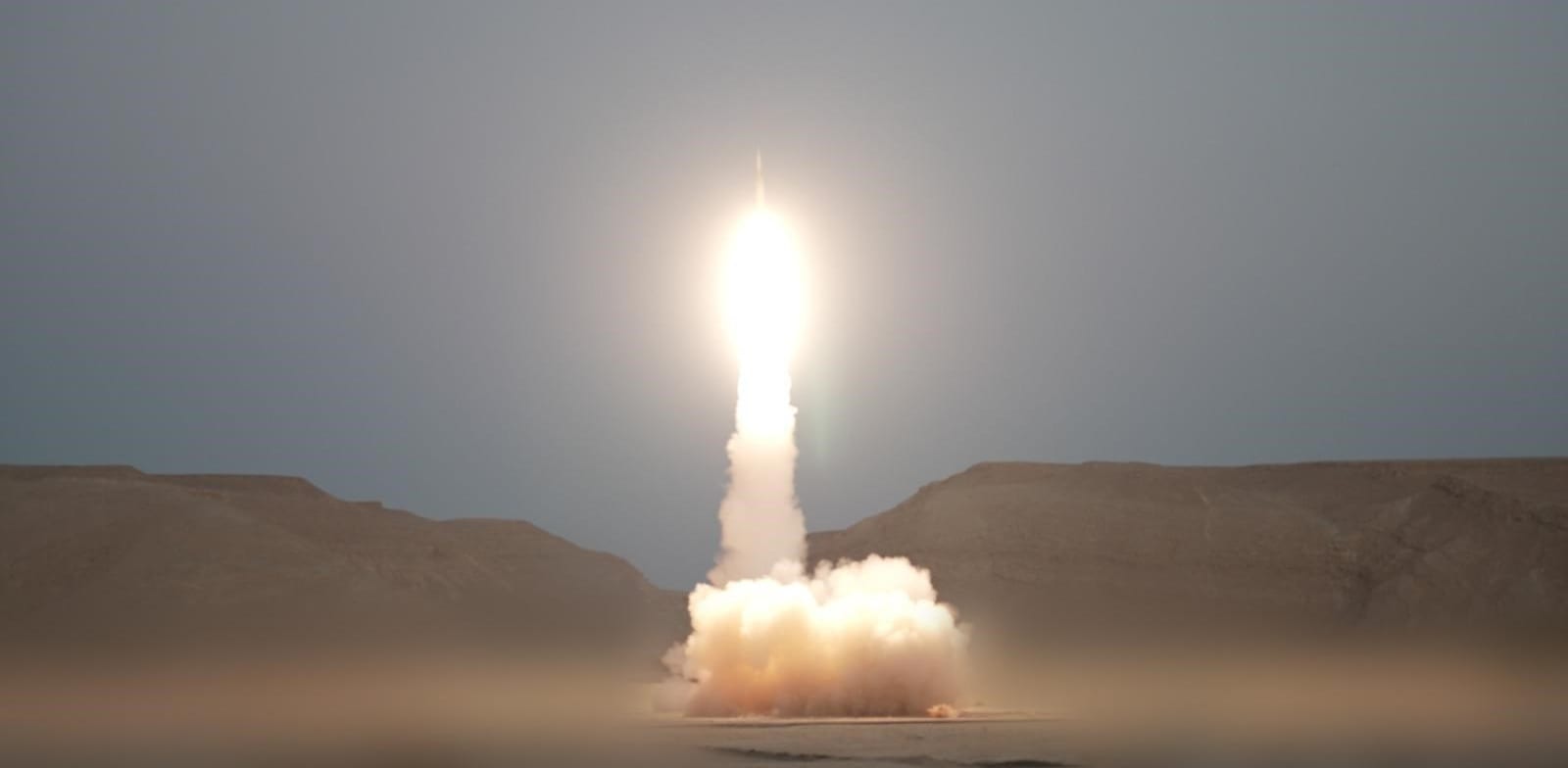Iron Dome, Arrow and David’s Sling have become synonymous with national success. Rafael, Israel Aerospace Industries and Elbit Systems have won great praise, and with major justification, but a fundamental key to the success of Israel’s air defense lies in the multi-layered defense system that many countries around the world are trying to copy. The program has been led by the Ministry of Defense’s Directorate of Defense Research & Development (DDR&D) (MAFAT), which has been managing the development and production of Israel’s air defense since 1991.
The director of the Israel Missile Defense Organization (IMDO) since 2016 is Moshe Patel, one of the veteran professionals in the field, who leads a number of critical national missions in his role, including: planning, development, and production of air defense capabilities, ongoing coordination and research with the US, which is a partner in Israeli technologies, and responsibility for skyrocketing sales, with International Defense Cooperation Directorate of the Israel Ministry of Defense.(SIBAT) data showing that about 48% of all Israeli defense exports in 2024 (totaling about $14.79 billion) were air defense systems.
30 years in the world of Israel’s air defense “
When there is war and operational events, lMDO is deployed on all fronts, in all defense industries, in the core of the Air Force. Every event, successful or not, we analyze in real time and learn for the future,” Patel tells Globes in a special interview. “If something is good, we will pass it on to the other systems. If there is a need to improve, we find the solutions and pass on our operational recommendation. All of our systems have experienced changes, after we sat down with the industry to examine implementation.”
The results of Israeli air defense against the Iranians as part of Iran operation were unprecedented by any criteria, even though every ballistic missile strike leads to serious consequences. About 86% of Iranian ballistic missiles were intercepted by Israeli and US systems (THAAD and AEGIS), and about 99% of drones. “As a matter of fact, our expectations were lower than the results,” admits Patel. “There are achievements here that go beyond the basic demands. Regarding Arrow 3, we are implementing the lessons learned from the operational events and continuing to improve the system.”
Moshe Patel (63), married and a father of four, is a man who has devoted most of his life to the defense of the country. He began his defense technology career as a computer engineering student at the Technion, graduating with honors, followed by an MBA from Tel Aviv University. Early in his service, he came into contact with the Americans, due to his work in the Air Force’s software units, where he was involved in F-16 avionics systems. He subsequently worked on command and control systems, and in 1996 he first reached the defense directorate as head of the system engineering and integration branch of the Arrow system. He was involved in the development of the first Arrow system in 2000 and held additional positions in the Ministry of Defense, including as a representative in Washington and in his last position as a uniformed officer (colonel), he served as a technical officer until 2007. About a year after his release, he moved to Elbit Systems unit Elisra, where he worked on missile defense command and control systems. In 2015, he was promoted to the position of director of the electro-optical solutions division for missile defense, and in 2016 he became head of IMDO.
RELATED ARTICLES
“I’ve been in the field for nearly 30 years. When we first started working on the Arrow, I said to myself, ‘We’re building an excellent system that will make it clear to the enemy that we can defend against attacks.’ I thought we were building a good deterrent capability, but I wasn’t sure we would use it,” says Patel. “To see a system that I’ve been working on for 30 years and my predecessors for even longer come to fruition is wonderful. The system works as smoothly as planned.”
He provides a creative explanation for the technological challenge that the Arrow system faces – a missile hitting a missile. “Imagine that a person on the Azrieli Tower in Tel Aviv throws a pin into the air in a ballistic way, and someone else is in Rabin Square and needs to hit that pin with a pin. This is the engineering scenario that requires examining, among other things, the changes in the winds, what the pin looks like, and what needs to be done to launch our pin just in time to hit the one launched from another place.
Preparations for the hypersonic threat have already begun
As has been evident since the start of the war and especially in the operation against Iran, Israel came prepared for the missile and rocket threats. However, the threats that Israel faces are not the most severe today, or in the near future. Various countries in the world, including North Korea, possess intercontinental ballistic missiles. These missiles challenge defense systems, among other things, due to their high speed (Mach 5 and above), long flight range that makes early detection difficult, and means of deception
In addition, there is the hypersonic threat, which is a combination of capabilities between a ballistic missile and a cruise missile. A hypersonic missile is not a ballistic missile, but it rises like one. The hypersonic missile also does not reach a ballistic altitude, but enters an airspace of 30 to 70 kilometers, while flying at an extremely high speed of 15-20,000 meters per second. In addition to that high speed, the hypersonic missile also poses a challenge due to the trajectory it takes, which resembles a pebble jumping on water, making it difficult to predict where the threat will arrive and from where it will dive in order to strike.
“We always look a few steps ahead and try to be, as before, prepared and ready for the next threats,” says Patel regarding these two threats. “Upgrades and improvements have already been made to the software and hardware in each of our systems. We have far-reaching plans that existed regardless of the war, and we continue to accelerate them.”
Do armies today have the hypersonic threat in its entirety? “
A lot of people brag about it and there is also talk. The world is working on finding solutions. At DDR&D, we are always looking at dealing with future threats. Some of our industries have begun to think about solutions, and I assume we will get into this topic
The company that has been developing a dedicated interceptor for the hypersonic threat for several years is Rafael, with a single-shot system. However, it is at an early stage compared with other air defense systems being promoted by Israeli defense industries.
Among the future developments, in which the IMDO in general and Patel in particular form an integral part of the management, the Arrow 4 and Arrow 5 systems stand out. “Arrow 4 is a system that will replace Arrow 2,” Patel notes. “We are going to bring a modern, innovative interceptor missile, with lessons learned from Arrow 3 and Arrow 2. It will be much more robust, while paying great attention to mass-producing the missile effectively. We are in advanced stages, with the Americans. It is an interceptor that will meet existing and future threats.”
What is the aim of Arrow 5?
“Arrow 5 is not a replacement for Arrow 3, but complementary. At this stage, the industry is offering ideas, and we are accompanying the process. It will definitely be a significant leap forward. Arrow 3 has a big future with its phenomenal success, there is no precedent for its success rate.”
The relationship with the US throws up a challenge
In the summer of 2023, the Arrow 3 system was sold to Germany, in Israel’s highest defense sale ever: $3.5 billion. Last month, Patel led a delegation to Germany that dealt with preparations for the delivery of the systems in the coming months. IMDO is also responsible for coordination with Finland, following the sale of the David’s Sling system for about $390 million. “The very fact that the industries are simultaneously managing not to neglect Israeli needs despite foreign needs is a badge of honor for each of the industries,” Patel says..
In this context, he recalls a conversation he had behind the scenes with his German counterpart, during the war. “He told me, ‘Even if you told me we were going to postpone, I would understand. But you can do both.’ We are sticking to the German plan and the Finnish plan on schedule. The contribution of the industries and their employees is amazing, some of them are in the reserves – coming out of the reserves and going to work, before returning to base. The sacrifice is amazing.
How did the connection between the war and the deals affect the IMDO?
“The scale of the projects and production, certainly the deals signed with Germany and Finland, required us to increase our manpower. Some of our licenses from the Americans include a requirement to avoid harming Israeli programs. Therefore, we increased our manpower by 20%. Our work requires close contact with industries for the purpose of executing contracts, monitoring and guidance, coordinating with the IDF, the Ministry of Defense, the National Security Council, the government, and of course the US, to whom I am indebted for their part in development and production.”
To what extent is the US integrated into Arrow 3?
“It works hand in hand with us in Arrow 3. They receive a detailed overview of what happened in each operational event, and they also share with us about the functioning of their systems. We deal with questions such as what happened, and how to improve coordination between the systems. We built an incredible infrastructure that began as a crazy US demand for connectivity capabilities with our systems. From the first day of Arrow, we created this, and the orchestra played well in previous events but especially during the Iran operation. They are very involved, producing 50% of the components.”
The fruitful cooperation between Israel and the US also entails a notable challenge. It is prohibited to sell a jointly produced system, for example Arrow 3 and David’s sling, without US approval. In contrast, US approval was not required for the sale of Rafael’s Spyder system to Romania last week (for about €2.2 billion) as it is completely made in Israel. Patel admits that although there is great openness on the US side to sales, the Ministry of Defense itself exercises great caution.
“Our air defense systems are particularly critical for the State of Israel. First of all, there is the Israeli process that includes the Defense Export Control Division (DECC), the defense ministry’s security officials, and the IDF. Only then comes the US part, whose understanding of sales has increased in recent years. In addition, pressure is being exerted by various countries, which tell the US, ‘We want it too.’ The enormous demand in the market also leads to a limit on how many US systems can be marketed. There is international pressure and need, and joint production of the systems with the US streamlines the process and reduces costs, a combination of good interests.”
Patel defines the close cooperation with the US as a “long-term marriage.” He says, “Right now we are continuing to investigate what happened with the Houthis, what they saw, what can be done next, what they need to learn and what they need to improve. It has become more than just a professional friendship. It is mutual care, influence, amazing relationships where not only do we benefit from the generous money, but also from joint management, joint deliberations, what to develop, what future generations will do, what is right to do. If they encounter problems, then they tell us to be careful, and there is direct investment in different directions. On the other hand, sometimes they give recommendations, and then they see our technological prowess, and after we implement it, they implement it themselves.”
What is the scale of international competition in the field of air defense?
“The competition is great, but not many countries have the ‘Combat Proven’ stamp. Only a few do, and when you consider the number of our interceptions, it is significant. With Iron Dome and Arrow, it is crazy, and with David’s Sling too. It is a quality that not many have. We have undergone many trials, simulations, but the operational baptism of fire – bringing a system that has been tested in battle and proven itself – is a completely different world.”
Will US independence come at the expense of Israel?
Under the current memorandum of understanding (MoU) with the US, $500 million a year are allocated for joint air defense projects, but this is only until 2028. The future of the next MoU and its content are still shrouded in mystery, all the more so in the wake of US President Donald Trump’s ambition to increase US independence and his grandiose “Golden Dome” air defense program.
Patel explains that in addition to the $5 billion granted Israel over a decade, there were years during which the US additionally funded other projects. In 2019, for example, an Arrow 3 trial was conducted in Alaska, for which US funding reached $700 million. In 2021 during Operation Guardians of the WAll, a grant of $1 billion was received, and during the current war, $5.2 billion has been received for interceptor missiles and promoting the Iron Beam laser air defense system.
“$500 million a year is significant. When I was first at IMDO and in my position in Washington, when we would receive a certain budget from the US administration, we would ask for additions. It’s a problematic situation because you present the needs, and then Congress says to move from point A to point B. In such a situation, MDA (the US Missile Defense Agency) had to cut other programs. In a situation with $500 million a year for a decade, you can plan long-term, and that is important.”
Isn’t it concerning that there is still no certainty from 2029? “As for 2029, it is left to the dialogue between the countries. We will have to talk about it, at the decision-making level. First of all, the government and the National Security Council need to make a decision on what and how, and start processes with the administration and Congress.”
Published by Globes, Israel business news – en.globes.co.il – on July 13, 2025.
© Copyright of Globes Publisher Itonut (1983) Ltd., 2025.








